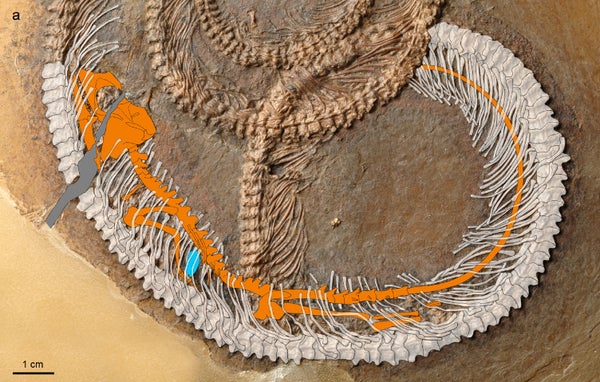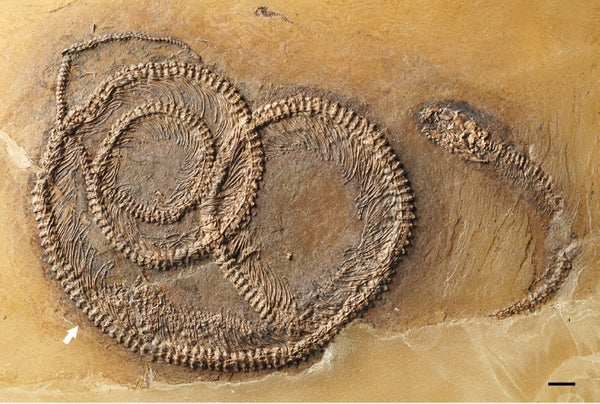This article was published in Scientific American’s former blog network and reflects the views of the author, not necessarily those of Scientific American
There are so many questions to ask about prehistoric creatures. How a species evolved, why they went extinct, what they looked like in life, what they sounded like... not to mention who ate whom. Look at paleoart and it's clear that we're often obsessed by the details of what was on the menu of long gone species. This isn't as easy to work out as you might think. It's often possible to narrow down the range of what an animal ate based on its anatomy and what else was alive at the time, but, more often than not, we lack the bite marks, gut contents, and fossil feces to give us the specifics we yearn to know. That's what makes a fossil from the 48 million year old strata of Germany an exceptional insight into food webs long gone.
The specimen, described by paleontologists Krister Smith and Agustín Scanferla, was found in the famous Messel Pit. This spot has given up beautifully-preserved remains of birds, primates, reptiles, and more, including this fortuitous find. It's a juvenile of an Eocene snake named Palaeopython fischeri with two surprises inside. Within the snake there is an ancient relative of basilisk lizards - Geiseltaliellus maarius - and within the lizard are the remains of an insect. This is as close as paleontologists are likely to get to a fossil turducken.

The remains of the lizard highlighted inside the body of the snake. Credit: Smith and Scanferla 2016
Finding a fossil in a fossil in a fossil alone is noteworthy. Many snakes can digest vertebrate prey very fast, within a matter of days, so to have recognizable remains inside this Palaeopython is a lucky break. But, Smith and Scanferla point out, what makes this trio so special is that they provide some new clues about the ecology of these animals.
On supporting science journalism
If you're enjoying this article, consider supporting our award-winning journalism by subscribing. By purchasing a subscription you are helping to ensure the future of impactful stories about the discoveries and ideas shaping our world today.
The lizard species is the most common in the Messel deposits, and a previously-found specimen had what appeared to be plant fragments in its gut. Finding a lizard with insect parts inside adds evidence that these reptiles were not strict herbivores. More than that, Geiseltaliellus is thought to have been a tree-dwelling lizard, so perhaps Palaeopython slithered around in the trees of the time. On top of that, Krister and Scanferla point out, a lizard in the belly of a juvenile serpent fits with the general picture of snakes like Palaeopython feeding on lizards as juveniles before shifting to bulkier prey as they get older. Testing that idea relies on finding additional, older snakes with gut contents - a tall order given how capricious the fossil record can be - but if there's a place where such a fossil might be found, it's Messel.
Reference:
Smith, K., Scanferla, A. 2016. Fossil snake preserving three trophic levels and evidence for an ontogenetic dietary shifts. Palaeobiodiversity and Palaeoenvironments. doi: 10.1007/s12549-016-0244-1
